Affiliate links on Android Authority may earn us a commission. Learn more.
Wearable tech: A brief history and a look into the future
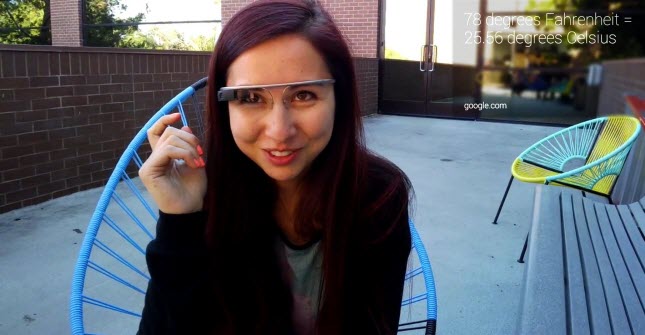
- Wearable computing is not exactly new, but the concept has been refined over the decades.
- The definition of wearable computers has evolved over time, much like how the definition of “smartphones” has changed.
- Wearable tech has mostly involved head-mounted displays and wrist-mounted user-interfaces like watches.
- Wearable computing is no longer reserved for uber-geeks, especially with Google Glass and smartwatches now going mainstream.
- These user interfaces are not just reserved for mobile computing, but also for other purposes, like accessibility, learning, research and navigation.
The advent of wearable computers
Wearable computers are basically small and compact electronic devices designed to be worn by a user. They are also referred to as body-borne computers, considered as a type of wearable technology that has in its core an electronic device that performs calculations and processes information. With this definition, watches from the 1990s that doubled as calculators can be considered as wearable computers. However, today’s concept of a wearable computer has advanced into something that is more than just simple calculations and information processing. This is similar to how devices are being classified as smartphones. Before, many advanced phones were already referred to as smartphones but were eventually relegated to being simply called “feature phones” as more powerful smartphones emerged. Today’s wearable computers are characteristically more powerful, more efficient, and more compact. They also possess a greater range of features and are more convenient to wear. Additionally, they feature better technologies in terms of displays, processors, batteries, and input and output systems. There’s still so much room for improvement but we may have to revisit the predecessors and forefathers of these modern wearable tech to better appreciate all the features we already have.
1980s
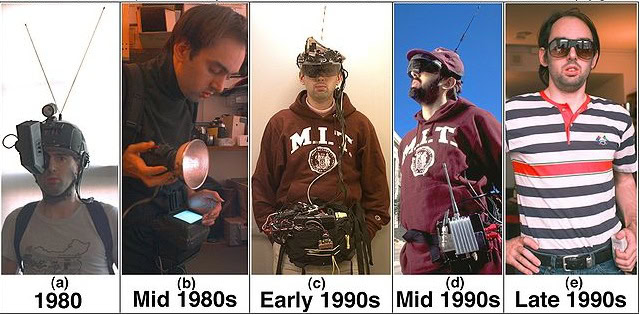
This is the decade when the pioneering wearable computers were introduced. In 1981, a 6502-based multimedia computer was designed to be worn as a backpack by Steve Mann, a researcher and inventor renowned for his works on computational photography, high dynamic range imaging, and wearable computing. In 1983, toe-operated computers were commercialized based on the Z-80s for counting cards. In the latter part of the decade, a head-mounted display called Private Eye was developed and marketed by Reflection Technology. It had a red monochrome display with a resolution of 720×280 pixels and a 1.25-inch screen size that appeared like a 15-inch display when viewed from an 18 inch distance.
1990s
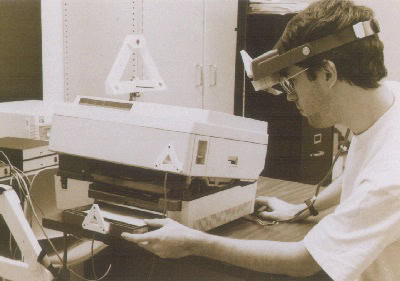
The first student electronic notebook that featured the Private Eye and mobile IP was demonstrated during the start of the 1990s. It used a Toshiba diskless AIX notebook computer prototype and featured TCP/IP based services, NFS mounted file systems, stylus-based input, and a virtual keyboard. In 1991, through a Scientific American article entitled “The Computer for the 21st Century,” Mark Weiser proposed the idea of ubiquitous computing. In 1993, a wearable computer system was developed using a kit made by Park Enterprises, a Private Eye display, and the Twiddler chording keyboard produced by Handykey. This system eventually evolved into what is now known as the MIT Tin Lizzy wearable computer design. Fall of the same year, BBN completed the Pathfinder system, a wearable computer that features a radiation detection system and GPS. Also in 1993, the KARMA (Knowledge-based Augmented Reality for Maintenance Assistance) system was developed. By 1994, a wearable computer capable of continuously recording interactions with people and devices was developed. This was called “Forget-Me-Not” and it featured wireless transmitters. Still in 1994, a “wrist computer” was invented and introduced during the CHI-94 conference in Boston. It was developed from a modified HP 95LX palmtop computer and featured a half-QWERTY keyboard. 1994 saw two more major developments in wearable computing with the initiation of DARPA’s Smart Modules Program and the development of a head-mounted camera called “Wearable Wireless Webcam.” These progresses in wearable technology became more exciting as Boeing hosted a wearables conference in Seattle in 1996 and the first IEEE International Symposium on Wearables Computers was held in 1997. In 1998, the Trekker was introduced. It was available to the public for a ridiculously high $10,000 price tag.
2000s
The earlier years of the new millennium weren’t as productive in the field of wearable computing as today. No major milestones were reached, but there were a few systems created in the pursuit of wearable computing. Nevertheless, the Tinmith wearable computer by Dr. Bruce H. Thomas and Dr. Wayne Piekarski was introduced in 2000 at the ISWC conference. It was a system created to support research in augmented reality.
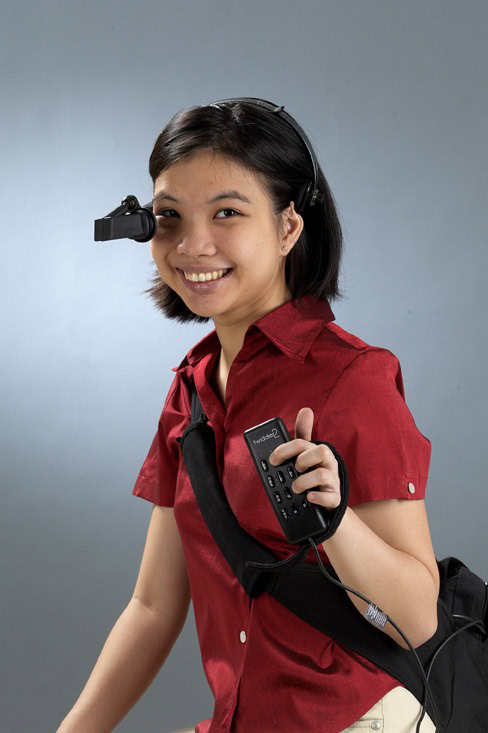
In 2002, Xybernaut’s Poma Wearable PC was introduced. It won an award from a tech magazine but did not find commercial success. In 2003, the Fossil Wrist PDA was released, running on Palm OS 4 and offering MicroUSB to PC synchronization. Moreover, the W200 wearable computer from Glacier Computer was introduced in 2009. It was designed to run either Windows CE or the Linux operating systems. It featured a touch color display with a 320×240 resolution, backlit keyboard, and integrated wired and wireless connectivity including Bluetooth, Wi-Fi and GPS. The W200 was designed for emergency services, field logistics, and security and defense purposes.
2010s

The new decade is ushering in renewed interest in wearable computing as many technologies have matured. With components such as displays, processors, batteries, and memories becoming cheaper, more efficient, and more advanced, developing wearable tech has become easier. The early 2010s has seen the introduction of the sixth generation iPod Nano, which comes with a wristwatch attachment that enables it to act as a wearable wrist-worn computer. The new decade also popularized the smartwatches and established them as a new segment in consumer electronics. Likewise, the 2010s brought us Google Glass, which can arguably be considered the best form yet of the earlier wearable computers pioneered by Steve Mann. Of course, similar products from other companies are expected to rival or even surpass Google Glass but as of this writing, only Google Glass has reached traction so far, with verifiable details, features and specifications.
Smartwatches
After the rise of the smartphones, wearable computing technology has jumped on the “smart” bandwagon to come up with a counterpart or complementary device: the smartwatch. Wristwatches have adopted new technologies to do more than just displaying time and date. They now come with significantly better displays, connectivity, and software that match those of smartphones. The definition for a smartwatch, however, is quite ambiguous. There are no well-established standards as to what qualifies as a real smartwatch. Nevertheless, among major international manufacturers, it is Sony that introduced the world’s first smartwatch in what the company aptly but uncreatively calls the Sony SmartWatch. This smartwatch does its job as a wristwatch and pairs with a smartphone to offer a number of functions like viewing social media feeds, reading text messages, receiving notifications, and serving as a remote control for a smartphone. Sony’s smartwatch fits the bill on what can be the ideal wrist-worn device.
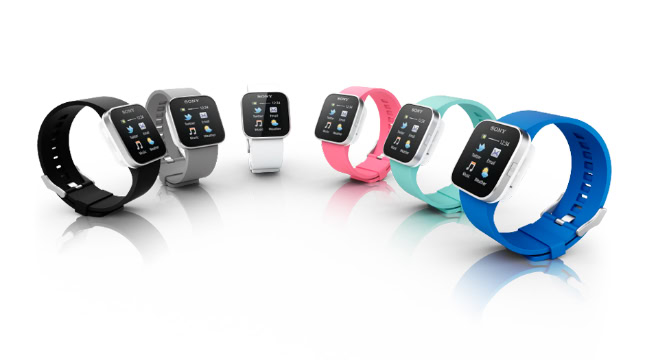
Of course, before Sony outed its own smartwatch, there were a number of smaller companies that already came up with their own versions of the device. Chinese manufacturers have already developed wristwatches that were capable of making calls and accessing the Internet even before the Japanese electronics giant introduced its smartwatch. These devices left a lot to be desired in terms of quality and reliability, but they were already able to implement the concept of a wristwatch that can make calls, receive text messages, process information, make calculations, and access the web. Other players in the consumer electronics field are widely believed to be in the final stages of developing their own versions of the smartwatch. Apple, for instance, has already applied for an “iWatch” patent in Japan and beyond. Qualcomm is expected to launch the Zola smartwatch in September. Intel is reported to be experimenting with smartwatch product. A Samsung VP confirmed that it is currently working on a smartwatch. Google is also rumored to be developing a smartwatch based on the Android operating system. However, it is a group of college students from India that could be considered the first to launch a smartwatch that offers the full features of the Android OS, also capable of making calls and taking photos. This £150 ($227) smartwatch is called Androidly and offers Bluetooth, GPS and Wi-Fi connectivity. Other smartwatches worth mentioning are the Pebble Watch, MotoActv and WIMM One. Pebble Watch is a smartwatch developed by Pebble Technology under a crowd-funded model launched on Kickstarter. It features a 144×168 pixel 1.26-inch low power memory LCD display more commonly referred to as an “e-paper.” The MotoActv is Motorola’s version of a smartwatch that comes with a 600 MHz OMAP3 ARMv7 CPU, 256 MB of RAM, 8 GB flash memory, and Bluetooth connectivity. It also has an FM tuner and runs on Android. Its display is a 1.6-inch capacitive multi-touch LCD with a resolution of 220×176. WIMM One, on the other hand, runs on a modified version of Android and features a transflective bi-modal screen, 3-axis magnetometer, 3-axis accelerometer, Bluetooth, Wi-Fi, and USB connectivity.
Google Glass and other “eyewear computers”
Fortunately or unfortunately, there isn’t a generic term yet for this new type of mass market wearable computer pioneered by Google. (While Google is certainly not the first ones to design a wearable device in the form of glasses, they are the first ones who have successfully garnered enough mainstream interest.) Google Glass would seem to establish a new kind consumer electronics device distinguished by its integration of an optical head-mounted display, augmented reality, camera, web access, and voice-based interaction.
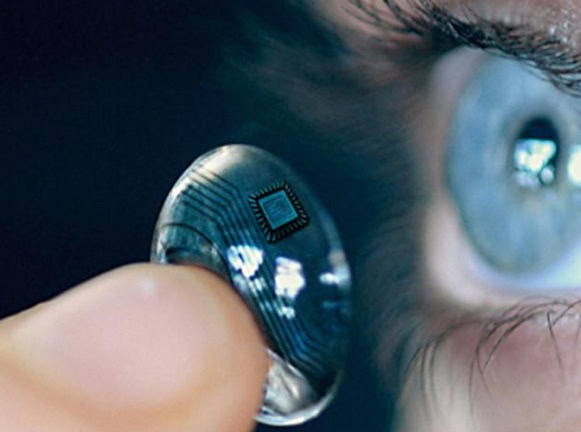
Aside from being considered a wearable computer, Google Glass is also categorized as an “ubiquitous” computer — mainly because it is meant to be used both actively and passively. Some of the device’s notable features are 5 MP camera with 720p HD video recording, touchpad input, a 640×360 display, Wi-Fi, Bluetooth, gyroscope, accelerometer, magnetometer, ambient light sensing, and a bone conduction transducer. It has an OMAP 4430 dual-core CPU and runs on the Android operating system. A number of companies are expected to release their Google Glass counterpart devices. One of them is Scope Technologies, which has partnered with Epson in developing a computer-assisted eyewear dubbed as an “augmented reality training system.” Another possible rival is the Spark from Seebright. Spark is a head-mounted device intended to provide an immersive experience by allowing its user to look into the small details of an object being examined or to see different points of view. Innovega, on the other hand, is embarking on a more ambitious goal of developing a contact lens that presents images right on top of a user’s eye to enhance normal vision. Then there’s also Vuzix, which has been touted as one of the bigger potential competitors against Google Glass.
Technologies that improve wearable computers
Thanks to the advancement of various technologies, using wearable computers has now become less unwieldy and awkward. More efficient and smaller high capacity batteries provide enough power to run wearable devices. Thinner and sharper displays now make it possible to create more comfortable means through which users interact with their devices. Touch input systems have become more responsive. Likewise, processors have become faster without overheating or requiring active cooling systems. They can even be enclosed in dust- and water-protected cases without becoming overheated. Sensors have also become smaller. Who would have thought that it is now possible to clump an IR blaster, accelerometer, barometer, thermometer, proximity sensor, pedometer, and gyroscope in a 7.9-millimeter thin device?

Things will only get better as companies perfect their more power efficient, sharper, and flexible displays. The Koreans have also reported having developed a flexible battery. NFC has made file sharing and the interconnection of devices easier. Moreover, hydrophobic coating technologies have advanced that, now, devices don’t need to be sealed to be made water-resistant or waterproof. We are still in earlier years of the decade but the amount of new technologies and technological advancements we are witnessing makes the future of wearable tech more anticipating than ever.
What do we need wearable computers for?
I would have wanted to write this part in an earlier paragraph. However, considering how wearable technology has been progressing, it would seem more appropriate to somewhat use this enumeration of purposes as a summary after examining the development of wearable computers through the years. Wearable computers have doubtlessly become significantly better since they were conceptualized before the 1980s. They are expected to achieve near-perfection and possibly undergo another technological revolution in the years to come. Therefore, wearable computers are expected to be more useful in serving the scope of purposes listed below:
- Enabling ubiquitous computing and wireless communications
- Assisting visually-impaired and hard-of-hearing individuals in interacting with their environment
- Aiding deaf-mutes in communicating with other people
- Recording and documenting activities, processes, and events (especially for scientists, or perhaps intelligence agents)
- Accessing and sharing information quickly and wirelessly
- Making computations and preparing electronic documents on-the-go
- Multimedia entertainment
- Schedules setting and tracking
- Capturing and sharing textual, audio, and visual data
- Interacting with or controlling other electronic devices
- Facilitating learning and instruction
Even with Google Glass expected to go mainstream soon, we’re only hitting the tip of the iceberg in terms of the potential of wearable computing, especially with how quickly development has accelerated compared to the previous decades. In the future, instead of smartphones and tablets, perhaps we will all be plugged into the cloud through our eyeglasses, watches and even our clothes. Isn’t this an exciting time we live in?